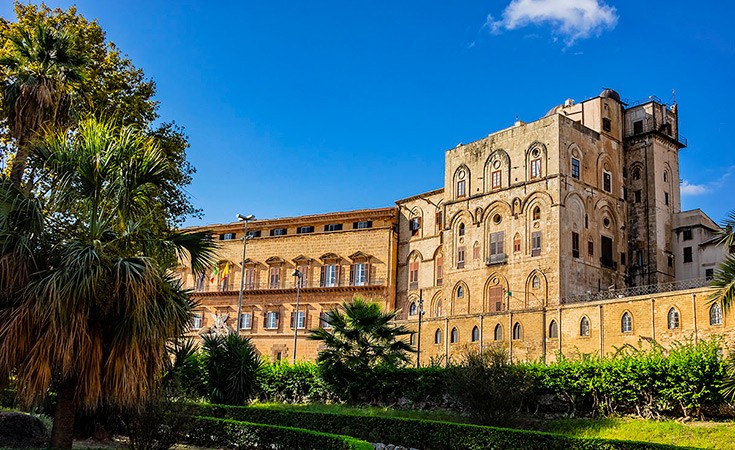
The Royal Palace (built in XI-XII century) stands in the oldest part of the city of Palermo, the area of the first Punic appropriations, the traces of which are still visible today in the basement of the factory.
The Royal Palace represents original and rare combinations of Islamic and Romanesque styles, the result of interaction and coexistence between different cultural components. The Palace was built during the rule of Ruggero II in 1130. He was also involved in construction of the most representative buildings such as the Greek Tower, reconstructed in later Renaissance period; the Pisan Tower, still existing; the Joharia (from the Arabic word “al-jawhariyya”, which means "jeweled"), where it is still possible to admire “Sala dei Venti” or the Hall of the Winds and the so-called "Stanza di Ruggero" or Ruggero’s Hall, with its Byzantine mosaics from the age of William I and William II.
Due to the refinement of decorations, it is believed that the Pisan Tower and Joharia, which mainly represent Islamic characters, hosted the apartments of the Norman rulers and the rooms for moments of leisure and representation. The cultural value of the Royal Palace of Palermo also lies in its continuity of use. As the former seat of the oldest European parliament and a place of power, the Palace has maintained its representative functions unaltered: today, in fact, it is the seat of the Sicilian Regional Assembly.
The most stunning part of this palace is the Palatine Chapel. It was built by Ruggero II and represents an expression of the cultural syncretism that distinguished the Ruggerian era, and one of the best-preserved medieval monuments both in the architectural and decorative sphere. The building consists of a raised presbytery with a central plan and a longitudinal body with three naves: the first is characterized by three apses and a dome on a square base of Byzantine ancestry, while the second is distinguished by the presence of acute arches on high piers, supported by columns and bare capitals.
The Palatine Chapel preserves different cultures - the Islamic, Byzantine and Western culture - which make the Chapel the most representative example of Mediterranean arts in the Norman Sicily. There are stunning marble decorations in opus sectile of the floors and walls, interesting for the abundance of porphyry, the Byzantine mosaics of the presbytery (from the reign of Ruggero II) and the naves (from the reign of William I and that of William II) and the Islamic paintings on wooden ceilings.
Unique in its kind is the extraordinary wooden muqarnas machine, starry polygons and domes of the central nave, painted decorations of which constitute the largest complex of a medieval Islamic painting that has been preserved.
In a space adjacent to the sacred place there is a series of furnishings, monstrances and reliquaries that came into possession of the Palatine clergy over the centuries, constituting what was, since medieval times, the Treasure of the Palatine Chapel: particularly fifteen decorated ivory caskets, belonging to a class of eburneous objects, very characteristic of the Norman age of Sicily.
This truly is the most beautiful Chapel one can see in the entire Europe and we advise our visitors not to miss it while in Palermo. Since it is hard to describe with words the splendid of the Palatine Chapel, we advise our visitors to take a look at the photos of this Chapel on our website. Be ready to be amazed.
 Ticket price for the Royal Palace in Palermo
Ticket price for the Royal Palace in Palermo
Royal Palace + the Royal Apartments
Regular ticket price: € 8,50
Reduced ticket price: € 6,50 (for students between 18 and 25 years old)
Royal Palace only
Regular ticket price: € 7,00
Reduced ticket price: € 5,00 (for students between 18 and 25 years old)
! From Tuesday to Thursday the Royal Apartments are closed.
 Working hours of the Royal Palace
Working hours of the Royal Palace
The Royal Palace is open from Monday to Saturday from 08:30am to 5:40pm